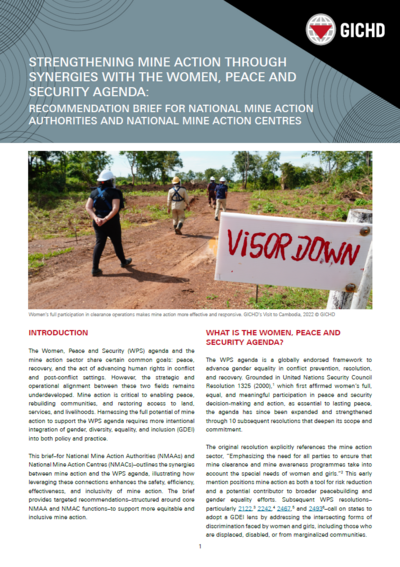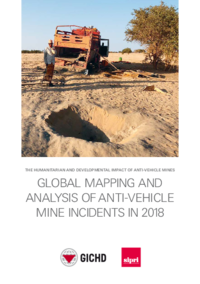Just released
GICHD Outlook Report 2026
This Outlook Report sets out how the GICHD intends to advance the five outcomes of its four-year Strategy in 2026. The report exemplifies our engagement in explosive ordnance risk reduction by describing planned activities in five...

- Available in English
Strengthening mine action through synergies with the women, peace and security agenda: Recommendation brief for national mine action authorities and national mine action centres
The Women, Peace and Security (WPS) agenda and the mine action sector share certain common goals: peace, recovery, and the act of advancing human rights in conflict and post-conflict settings. However, the strategic and...

- Available in English, French
Demining in urban centres is a race against time
Pascal Rapillard, GICHD Head of External Relations, Policy and Cooperation programme and Jérémy Repond, GICHD External Relations Officer, expand on how demining in urban centres is a race against time.

- Available in
Achievements and new challenges in mine action
Ambassador Stefano Toscano, GICHD Director, expands on the achievements and challenges in mine action.

- Available in
A Guide to Non-Technical Survey
Non-Technical Survey (NTS) is an important component of the Land Release (LR) process. NTS is the first operational step of the LR process and can be seen as the foundation for all subsequent LR activities.
This NTS Guide aims to...

- Available in English, Ukrainian
Global Mapping and Analysis of Anti-Vehicle Mine Incidents in 2018
This report presents and analyses AVM incident data from 2018. It follows up on and compares findings with earlier reports published by the GICHD and SIPRI examining AVM incidents in 2015, 2016 and 2017. Data in this report stem...

- Available in
National Capacities and Residual Contamination (Croatia)
Croatia is affected by explosive ordnance (EO) contamination that consists of mines and, to a lesser extent, explosive remnants of war (ERW), including cluster munition remnants, caused by the legacy of four years of armed...

- Available in
Key Performance Indicators and HMA Time to Standardize
Measuring performance is the norm across a range of human activities. But is it a norm in humanitarian mine action (HMA)? Some might suggest that it is. However, if we measure our performance, it is unclear whether we do so in a...

- Available in English
Long-Term Risk Management Tools and Protocols for Residual Explosive Ordnance Mitigation (Vietnam)
The Management of Residual Explosive Remnants of War (MORE) framework is a holistic long-term risk management (LTRM) approach for handling the reality of risks posed by explosive ordnance (EO). The current Geneva International...

- Available in
Vietnam Ageing Study Management of Explosive Remnants of War (MORE)
Every conflict leaves behind explosive remnants of war (ERW) in lesser or greater quantities depending upon the nature and duration of the conflict and the types and quantities of weapons used. How ERW are dealt with reflects...

- Available in
GICHD Annual Report 2018
In 2018, GICHD staff visited and supported 61 countries to improve mine action globally and locally and delivered over 30 training sessions and workshops. To carry out this work, our staff grew. As of the end of 2018, the GICHD is...

- Available in English
Minefield Clearance and Casualties - Holland 1945
In June and July 1945, two Royal Canadian Engineer officers, on their own initiative, carried out a review of the ongoing minefield clearance in Holland. The local military authorities deemed the review to be of significant value...

- Available in
